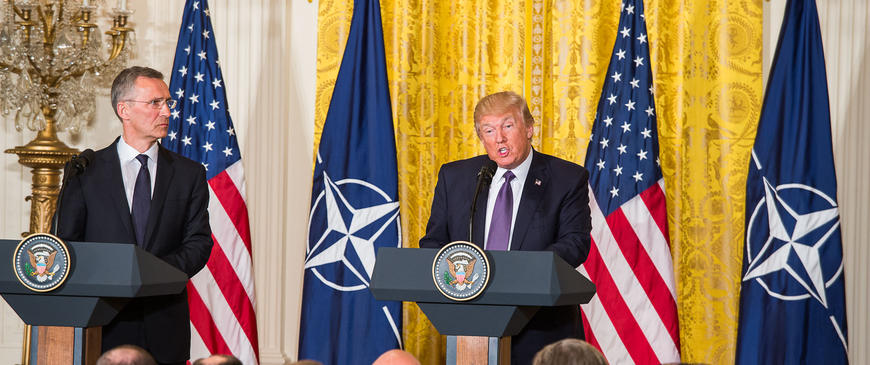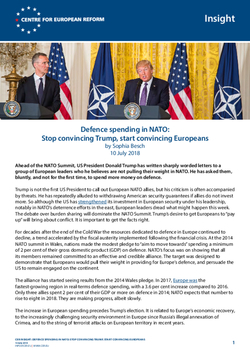
Defence spending in NATO: Stop convincing Trump, start convincing Europeans
Trump’s desire to get Europeans to "pay up" will bring about conflict at the NATO Summit. It is important to get the facts right.
Ahead of the NATO Summit, US President Donald Trump has written sharply worded letters to a group of European leaders who he believes are not pulling their weight in NATO. He has asked them, bluntly, and not for the first time, to spend more money on defence.
Trump is not the first US President to call out European NATO allies, but his criticism is often accompanied by threats. He has repeatedly alluded to withdrawing American security guarantees if allies do not invest more. So although the US has strengthened its investment in European security under his leadership, notably in NATO’s deterrence efforts in the east, European leaders dread what might happen this week. The debate over burden sharing will dominate the NATO Summit. Trump’s desire to get Europeans to "pay up" will bring about conflict. It is important to get the facts right.
For decades after the end of the Cold War the resources dedicated to defence in Europe continued to decline, a trend accelerated by the fiscal austerity implemented following the financial crisis. At the 2014 NATO summit in Wales, nations made the modest pledge to "aim to move towards" spending a minimum of 2 per cent of their gross domestic product (GDP) on defence. NATO’s focus was on showing that all its members remained committed to an effective and credible alliance. The target was designed to demonstrate that Europeans would pull their weight in providing for Europe’s defence, and persuade the US to remain engaged on the continent.
The alliance has started seeing results from the 2014 Wales pledge. In 2017, Europe was the fastest-growing region in real-terms defence spending, with a 3.6 per cent increase compared to 2016. Only three allies spent 2 per cent of their GDP or more on defence in 2014; NATO expects that number to rise to eight in 2018. They are making progress, albeit slowly.
The increase in European #defence spending precedes #Trump’s election.
The increase in European spending precedes Trump’s election. It is related to Europe’s economic recovery, to the increasingly challenging security environment in Europe since Russia’s illegal annexation of Crimea, and to the string of terrorist attacks on European territory in recent years.
While it matters for NATO solidarity that every ally moves towards the 2 per cent target, the spotlight is on the three biggest European countries, whose defence budgets are large enough that moderate spending increases can make a significant difference to NATO’s overall burden sharing. NATO’s top three spenders have all announced increases: the UK government has pledged to increase its defence budget by £1 billion every year until 2021; France’s budget is set to rise by €1.7 billion annually until 2022; and Germany is committed to increasing its 2017 budget of €37 billion to €42 billion by 2021.
Trump has singled out particularly Germany as a free rider. Other NATO allies also believe that Europe’s largest economy is underperforming on defence. While both France and the UK spend around 2 per cent of GDP on defence, with France devoting 1.8 per cent and Britain 2.12 per cent, Germany’s GDP share is currently just 1.24 per cent.
To hit NATO’s target Germany would have to more than double its defence expenditure between 2017 and 2024. It would have to spend more than any other country in the alliance except the US. This would be a significant undertaking for a country whose political elites are traditionally averse to using military force and which has major investment needs in other areas. In the lead-up to this week’s summit the leaders of all major political parties publicly committed to spending 1.5 per cent of German national economic output by 2024 – a difficult concession for some of them, and yet still less than the Wales pledge, which Germany signed up to. Even the planned increases will bring German military spending to just 1.31 per cent of GDP in 2019, with more long-term predictions foreseeing a decline to around 1.23 per cent by 2022.
The Germans are not the only ones pushing back against the 2 per cent commitment. The debate around the NATO target is well rehearsed because the metric has obvious shortfalls.
The NATO target’s focus on traditional defence spending ignores many of the current challenges to security, such as attacks on the stability of democratic political systems, climate change, or the root causes of terrorism, which are often better addressed through for example development assistance, or investment in cyber security. The comparison between what the US spends and what Europeans spend is also warped – whereas many European defence budgets will be spent almost entirely on NATO’s neighbourhood, the US allocates money according to its own broader geopolitical interests, for instance in the Pacific. The defence investment pledge also does not account for risks – some allies do not spend 2 per cent on defence but assume important operational responsibilities, for example deploying troops in Afghanistan and against ISIS. And, of course, increased defence spending means little unless it translates into improved military capabilities – Greece, which meets the 2 per cent guideline, spends as much as 73 per cent of its defence budget on personnel costs, wages and pensions, and it is not alone.
The criticism of the 2 per cent goal has pushed NATO HQ to take a more nuanced approach. The alliance wants members to focus their commitments in three ways. First, cash – because even though spending money on defence does not guarantee security, without it effective defence is nearly impossible. Second, political commitments – because the actual contributions committed to NATO in terms of land forces, aircraft, ships and dedicated personnel to the NATO Command Structure should count for something. Third, capabilities – because it matters not only that money is spent, but what it is spent on. Military leaders tend to agree on the capabilities that the alliance needs. European members should focus in particular on developing long-range air transport, precision-guided munitions, strategic intelligence and reconnaissance capabilities.
In an attempt to address the disconnect between defence spending and capability development, the Wales pledge also commits allies to devoting 20 per cent of their defence expenditure to equipment and research and development (R&D). But most European countries fall short of that target. At €2 billion or 1 per cent of total European defence expenditure, European spending on R&D has sunk to its lowest level in a decade. More than 80 per cent of public procurement and more than 90 per cent of research and technology are run on a national basis. The lack of co-operation between Europeans in the field of defence and security is estimated to cost between €25 billion and €100 billion annually. And national defence budgets are spent inefficiently: many European NATO members sustain uncompetitive defence industries as state-subsidised job creation schemes, or simply buy 'off the shelf' from third countries – mainly the US.
NATO tries to help nations decide what to invest in, to avoid duplication as well as capability gaps. Its defence planning process is built around members reporting to the alliance. NATO’s political ambition is translated into a list of capability targets, which are then allocated to nations. But NATO does not have the authority or the tools to hold allies to account for their commitments. In response to the criticism from the Trump administration, NATO has decided that allies will publish their annual defence spending plans detailing their cash commitments, troop contributions and capability investments. The results have been mixed: some plans only provide details for the next three years, while others do not even show how the country aims to hit the 2 per cent goal.
The debate around the #NATO 2 per cent target is well rehearsed because it has obvious shortfalls.
At present, the EU is not better placed today to manage European defence planning than NATO. The EU has come up with the new Co-ordinated Annual Review on Defence, or CARD, process, which will monitor European investment in the capability shortfalls identified by the European Defence Agency. But the new mechanism is voluntary, and relies on member-states’ aggregated defence plans, which makes it difficult to hold laggards accountable.
Recognising these shortcomings, the European Commission has placed its trust in carrots rather than sticks: it wants to consolidate the divided European defence industrial sector by including a budget for defence in the EU’s multiannual financial framework for the first time. And through the European Defence Fund (EUDF) the Commission wants to encourage member-states both to spend more money and to spend more wisely, by working together. Through the Multiannual Financial Framework (MFF) for 2021–27, the Commission will channel around €13 billion in total to the EUDF – €4.1 billion taken directly from the EU budget will fund collaborative defence research, and €8.9 billion will co-finance collaborative capability development projects. The Commission hopes that by providing initial funding, it will incentivise member-states to invest larger sums.
The defence fund programmes have yet to prove themselves, but they have the potential to encourage Europeans to spend more money and to spend it more effectively on capabilities that will ultimately be available to NATO. In the coming years both organisations must co-ordinate their defence planning as much as possible, to get Europeans to spend more money, and spend it wisely.
Despite these European efforts, the spending shortfall relative to the NATO target remains very large and will probably remain large for years to come. The US still has every reason to push its European allies to spend more: in 2017, the US accounted for 71.7 per cent of combined NATO defence expenditure. To put that commitment in to perspective, the US represents 51.1 per cent of the alliance’s combined GDP.
Considering #Trump’s disdain for multilateral organisations, it may not be possible to ever convince him of #NATO’s value.
Trump has communicated American concerns poorly. The danger of publicly singling out countries and their leaders is that it undermines alliance solidarity and cohesion, NATO’s strongest assets. Considering Trump’s disdain for multilateral organisations, it may not be possible to ever convince him of NATO’s value. Some on the receiving end of the criticism, particularly in Germany, would also add that the 2 per cent metric has become toxic by association with the American president, who is unpopular in Europe. The risk is that European leaders feel bullied –and that populations misunderstand defence spending as a concession to the US, rather than an important investment in European security.
It is not the responsibility of the US, however, to communicate to European voters that their leaders have committed to investing in defence. Europe would need to spend more on its own security no matter who was in the White House. This week in Brussels, European leaders will be occupied with managing Trump, bracing themselves for his press conferences and tweets. But they must also take ownership of the alliance and its achievements in order to sustain higher European investment in security.
Sophia Besch is a research fellow at the Centre for European Reform.


Add new comment